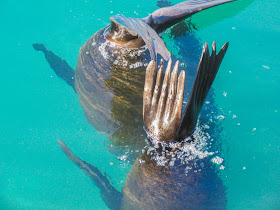The Cape fur seal (A. p. pusillus), also known as the South African fur seal, is one of two subspecies of the brown fur seal (Arctocephalus pusillus). The other subspecies is the Australian fur seal (A. p. doriferus).
 |
| Cape fur seals at the Cape of Good Hope. There are at least four to the left and one to the right. |
The Cape fur seal is found from Cape Cross in Namibia, down around the Cape of Good Hope, then to Black Rocks near Port Elizabeth, South Africa, on the east side of South Africa.
 |
| A mother and pup rest at the wharf in Kalk Bay, South Africa. |
The brown fur seal is the largest fur seal and the Cape fur seal is the largest of the two subspecies. Adult males are dark gray to brown with a mane that is darker, which consists of coarse hairs, and a lighter belly. Adult females are gray to light brown with a lighter throat and darker back and belly. The foreflippers are dark brown to black. Pups are born black and molt to gray with a pale throat within three to five months.
 |
| Mother and pup from a different angle. |
We saw them at the Cape of Good Hope, quite a ways away, sunning on the rocks next to the surf.
 |
| The big male is nearby. I assume the visible fur is part of the mane. |
 |
| The male has dried out a bit and the fur is showing more brown. |
 |
| Note the black flippers and hairy body. |
Later we saw them at Kalk Bay when we stopped to eat at a fish and chips restaurant just off the ocean, right next to where stalls of local fishermen were selling fish. Judy encouraged me to get near a large meal for a picture and against my better judgement I did. It whirled around and was inches away from biting me and pushing me into the water. It was really stupid on my part and I was lucky not to get hurt.
 |
| I assume this is mother and pup taking a dip. |










Sorry about that. He looked so friendly. A woman nearby did curtly remind me (after the seal about ate you for dinner), "They ARE wild animals, you know." I learned my lesson.
ReplyDelete